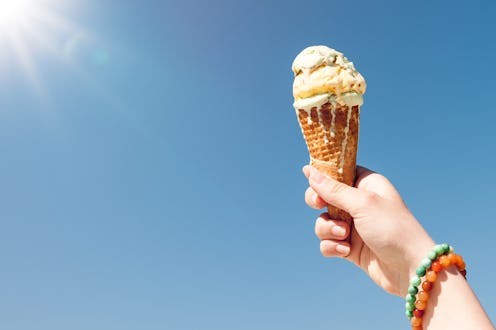Life
7 Gross Things Your Body Does That Could Mean You're Overheated
Everyone knows it's important to try to stay cool, wear sunblock while outside, and drink enough water, but sometimes that's not possible or it's simply too late. And when your body is overheated, it can lead to a number of issues and some pretty uncomfortable symptoms.
According to Mayo Clinic, there are three heat-related syndromes: heat cramps, heat exhaustion, and heatstroke, with heat cramps being the mildest and heatstroke being the most extreme. The three illnesses share some symptoms. For instance, someone with heat exhaustion could also have muscle cramps. That said, according to WebMD, "heatstroke can occur suddenly, without any symptoms of heat exhaustion." Mayo Clinic says that a doctor should be contacted if the signs and symptoms of heat exhaustion worsen or don't show improvement in an hour. Heatstroke requires immediate medical attention, according to WebMD.
A lot of focus tends to be put on wearing sunblock to avoid a sunburn while spending time outside in the summer, but it is also very important to look out for these other signs that could mean something even worse. Your body reacts in certain ways in certain conditions, and when it's overheated, here are some of the ways it will let you know.
1. Sweating Too Much
When you get hot, you sweat. It's healthy and it's your body's way of cooling itself off. But, if you start sweating too much, that can be a bad sign. According to WebMD, "drenching sweats" that are "often accompanied by cold, clammy skin or a sensation of prickly skin" can be a symptom of heat exhaustion. "Profound sweating" can also be a sign of heatstroke.
2. Not Sweating At All
But it's not only sweating too much that you have to look out for. Not sweating at all, at times when you should be sweating, is a bad sign. Dr. Tania Dempsey told Reader's Digest, "Initially, the body will try to cool itself off by sweating more. But as one gets more dehydrated, sweating can stop and this is very dangerous. Without sweat, the body loses its ability to cool itself off and the internal temperature will start to rise leading to heatstroke." Dr. Dempsey suggests leaving the heat if this happens, and drinking water, removing clothes, and applying ice packs or taking a cool bath.
Larry Kenney, a professor of physiology and kinesiology at Penn State University, told NPR that you have to be careful with this sign, because if you were sweating, but stopped, it could be hard to tell if the old sweat is still on you.
WebMD notes that not sweating could be a sign of heatstroke and recommends getting medical attention.
3. Heat Rash
A heat rash is caused by sweat ducts becoming clogged, and can be due to overheating. Thankfully, this one tends to get better on it's own if the person experiencing it comes out of the heat and cools their skin. That said, the Mayo Clinic suggests seeing a doctor if the rash increases in pain, redness, or swelling, the rash lasts more than a few days, pus drains from any lesions, lymph nodes in the neck, groin, or armpit swell, or the rash is accompanied by a fever or chills. There are different types of heat rashes, and it most commonly affects newborn babies since their sweat ducts aren't fully formed. On adults, heat rashes tend to occur in folds in the skin or where clothing rubs.
4. Tingling Skin
Kenney also mentioned a "tingling sensation in the skin" being a common sign of heat exhaustion or heatstroke.
5. Goosebumps
Goosebumps are another sign of heat exhaustion or heatstroke, according to Kenney. The Mayo Clinic also lists "cool, moist skin with goosebumps when in the heat" as a symptom of heat exhaustion.
6. Nausea
Nausea is a sign of both heatstroke and heat exhaustion. With heatstroke, it can be accompanied by vomiting.
7. Hard Muscles
Hard, tense-feeling muscles can be a sign of heat cramps, according to WebMD. Heat cramps often occur during or after working or exercising in the heat. The Mayo Clinic says that heat cramps can be brought about from losing fluid and electrolytes. If the cramps don't go away in an hour, Mayo Clinic recommends calling a doctor. They can be eased by drinking a beverage with electrolytes or clear juice, resting, cooling off, and stretching.
These seven issues are not the only signs and symptoms of heat-related illnesses. More information about symptoms, treatment, and causes can be found on WebMD, Mayo Clinic, or by calling a doctor.
